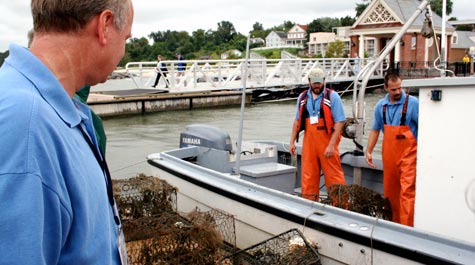The ghost hunters
Mapping derelict blue crab traps
Dave Stanhope and Kory Angstadt are using a side-scan sonar, a torpedo-shaped device that is towed by boat to map the bottom. They are searching for something lurking on the bay floor capturing and killing fish, crabs, and other animals in the Chesapeake. The killer turns out to be derelict “ghost” blue crab pots.
Stanhope, Angstadt, and others from the Center for Coastal Resources Management at VIMS (CCRM) have been mapping the location of derelict crab pots since 2005. “We like this project because it’s something tangible and relates to the health of the Bay,” says Stanhope.
"Our knowledge of side-scan technology has improved to help get the job done," Kory notes. “It took awhile to learn what we’re seeing, but we’ve done verification of side-scan results with what we actually pull up with a grappling hook.”
In January 2006, the CCRM team surveyed 33.5 square kilometers in the lower York River, locating approximately 676 abandoned pots. Many of these were still functional and catching a variety of fish and shellfish. Once crabs enter the top chamber of a pot, escape rates drop significantly and there is high mortality over time. The pots that have not degraded continue to fish due to a self-baiting phenomenon wherein the dead animals attract more animals into the trap. In lower salinity waters, abandoned pots can continue to fish 3 years or more. In the lower York River, the team estimates that each derelict pot captures around 50 blue crab and 13 Atlantic croaker per season.
CCRM is working to lower the impact of derelict pots by testing variations in cull-ring placement to maximize escape rates for undersized crabs. They are also testing whether pressed cardboard, degradable plastics, wood, metals, or bungee closures might degrade more quickly than current cull-ring materials, thus allowing animals to escape.




